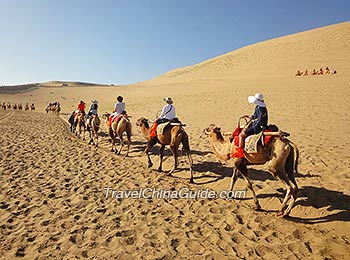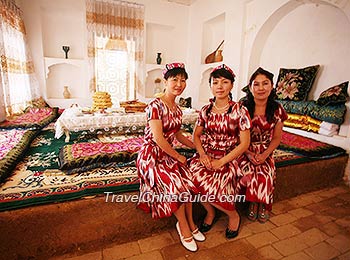Silk Road Facts
 Basic Facts:
Basic Facts:
Chinese Pinyin: Sī Chóu Zhī Lù
English Translation: Silk Road
Length: 4,350 miles (7,000 kilometers) with 2,485 miles (4,000 kilometers) in China
Active: The 2nd Century BC to the 1st Century AD
Location: From Asia to Europe passing through China, Kazakhstan, Kyrgyzstan, Tajikistan, Uzbekistan, Turkmenistan, Afghanistan, Iran, Iraq, Turkey, Greece, and Italy.
Chinese Regions along the Route: Shaanxi, Gansu, Qinghai, Xinjiang
World's Oldest and Longest Trade Route
| Before Western Han Dynasty (202BC - 9AD) | Small-scale business sprouted between central and western China, trading bronze ware, lacquer ware, and jade. |
| 138BC and 119 BC during Western Han | Zhang Qian was twice sent on a diplomatic mission to the Western Regions in China, forming the initial route, which enabled silk to spread and become popular. |
| 16 AD | Western Regions cut off the connection with the central court, and also broke the trade route. |
| Eastern Han Dynasty (25 - 220) | In 73AD, Ban Chao set off on a diplomatic trip to western China and reopened the road, and later his assistant extended this route to the Persian Gulf. In 166AD, the Roman Empire sent an envoy to China. Then ties with the Europe were formed through this road. |
| Sui and Tang (581 – 907) | The route developed into three branches, trading silk, porcelain, and tea. It entered the golden age, together with the maritime route, which even reached Japan. |
| Yuan Dynasty (1271 - 1368) | Italian merchant traveler Marco Polo reached China and introduced the prosperity of this trade route to the whole world through his book. |
| Ming and Qing (1368 - 1911) | It declined due to the rapid development of maritime trade. |
| Modern Times | The trading function fades but it now becomes a tourist route with many historical attractions along the way. |
A World Cultural Heritage Declared by Three Countries
Why is it called 'Silk' Road?
European Nobilities' Fascination with Silk
Traversing Vast Mountains and Deserts in West China
 |
| Beautiful Uygur Girls |
Diversified Ethnic Customs and Arts of Xinjiang
Most Popular Attractions to Travel
Why is China called China?
Revival of Modern Silk Road Economic Belt
- Last updated on Mar. 01, 2022 -
Questions & Answers on Silk Road Facts
Asked by Julie from USA | Dec. 14, 2021 22:42 Reply
Reply
What transportations were used on the silk road?
Answers (2)
Answered by Just a kid | Dec. 17, 2021 23:00 0
0 0
0 Reply
Reply
most likely camels
Answered by Wennie | Mar. 01, 2022 00:18 0
0 0
0 Reply
Reply
It's simple. It's camel.
Asked by JASONATOR3000 | Jun. 06, 2017 10:25 Reply
Reply
What were some of the most important facts about the silk road?
i Know it had its own road and trading routes but i need to know some more important facts.
Answers (2)
Answered by Henry from UK | Jun. 18, 2017 22:30 1
1 0
0 Reply
Reply
As the transportation developed not very well in ancient times, the Silk Road had served as the communication bridge of economy, politics and cultures between the oriental countries and western countries.
Answered by Liliian Blacksure from AUSTRALIA | May. 02, 2019 20:21 0
0 0
0 Reply
Reply
its 4000 miles long and was also known as the silk routes
Asked by Alan from USA | Apr. 16, 2016 10:13 Reply
Reply
is it safe to travel the silk road today?
Answers (1)
Answered by Stella from GEORGIA | Apr. 18, 2016 21:17 8
8 5
5 Reply
Reply
Yes, it is safe, but you should find yourself some companions. Many cities in China are distributed along the route and public transportation makes travel to each place easier and safer. But it traverses a vast desert in the western China. It is recommended you find a local guide; or, it will be quite easy to get lost.